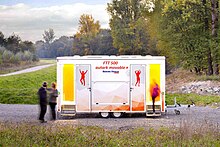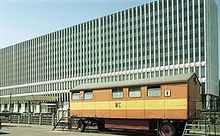Mobile toilet cubicle
Mobile toilet cubicles are used at squares and event locations with a lack of toilet infrastructure, for example at parties, concerts, sporting events, but also on construction sites and in container villages. As lavatories large-scale mobile come toilet container or toilet trailer used.
history
In 1973 the American soldier Fred Edwards, stationed in Germany, invented the mobile toilet because he did not want to relieve himself during maneuvers in the company of his comrades. Another reason was the unreasonableness of being confronted with the associated smells and noises. In his garage he screwed together the mobile version of a quiet place: a urinal and a container with a hole. Privacy was created by boards . The mobile toilet, which was given the name Dixi , was so successful that he left the military and was completely busy with its production in Germany.
Today, TOI TOI & DIXI is the world's leading supplier of such toilets .
to form
Bauklo
The so-called "building toilets" made of gray, galvanized sheet steel are well known . These are simply placed over a pit that absorbs the feces . The pit is filled in again after the building toilet has been removed. Because of the necessary pit, these toilets are particularly suitable for construction sites , hence the colloquial term. Since these houses no longer meet modern standards in terms of hygiene , environmental protection and odor nuisance, they are rarely used these days.
Chemical toilets
Usually chemical toilets are now installed in small plastic containers that only contain one toilet.
Toilet trolleys and toilet containers
Larger toilet containers usually contain a complete toilet area including a wash basin and are separated for men and women. These are partly converted construction trailers in which toilets, urinals and wash basins have been installed. There are also purpose-made containers , which are offered in a variety of configurations, to meet even high standards. Both water closets and chemical toilets can be used as toilets. Water closets have the disadvantage that they need both a fresh water connection and access to the sewer system; alternatively, a holding tank can be placed under the sanitary container.
Toilet containers in a new, modern design are fully installed and only require a water supply and waste water drain, as well as a power connection. Heating, hot water and ventilation are already installed at the factory.
Web links
Individual evidence
- ↑ Business with business. In: faz.net. Frankfurter Allgemeine Zeitung, June 3, 2018, accessed on June 3, 2018 .
- ↑ Rp-online.de: Book about the inventors of everyday objects - What the Dixi-Klo has to do with the Pope from June 16, 2012, accessed on June 11, 2015
- ↑ Claudia Fromme: Trouble because of Dixi-Klo - Blowin 'in the wind from May 17, 2010, accessed on June 11, 2015
- ↑ Berliner Zeitung.de: Anja Scheve - The Dixi toilet is 30 years old. A brief look back at an inventive story: Three little hearts on the road from August 6, 2003, accessed on June 11, 2015
- ↑ Florian Langenscheidt: German Standards - Brands of the Century , Dixi, p. 128, Gabler Verlag, 2006, ISBN 978-3834904362



